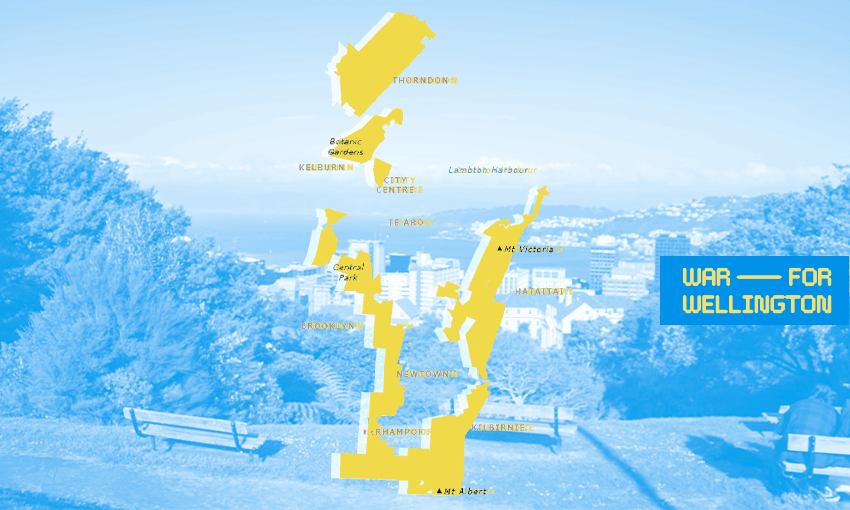With more people living in apartments, public green space like Wellington’s Town Belt will be the key to supporting a better, denser future in our cities, writes urbanist Jonathan Manns.
On the top floor of Wellington Museum is a brown wooden cabinet. Most people walk straight past. Inside is a collection of small, imperious clothes, behind which looms a towering bust of Edward Gibbon Wakefield. The decisions of this imposingly memorialised man continue to reverberate today, including in the capital’s city planning.
Wakefield was a convicted criminal and architect of New Zealand’s colonisation. He was influential as a founding father of the modern nation, its capital city and as the first Member of Parliament for the Hutt. He was also largely responsible for introducing the 1,061 acre Town Belt which now encircles Wellington’s central suburbs.
The story begins in 1827, when Wakefield was incarcerated in London’s infamous Newgate Prison. He was serving a three-year sentence for abducting and forcibly marrying Ellen Turner, a 15-year-old heiress, in the hope that her family’s wealth would fund a parliamentary career. He spent the time studying colonisation and writing a series of public letters which were published anonymously.
Upon his release in 1830 he joined others in actively lobbying for a new colony in South Australia. Parliamentary endorsement came in 1834 and Colonel William Light was tasked with setting out a plan for Adelaide. He drew on Wakefield’s work and consciously incorporated park belts into the design: establishing it as the continent’s first “parkland town” in 1836.
With efforts well underway in South Australia, Wakefield next set about making the case to colonise New Zealand. Within three years, he became director of the New Zealand Company and used the parkland towns model to design their settlements at Wellington, Nelson and New Plymouth.
The company’s surveyor, William Mein Smith, was sent from England to plan Wellington in 1840, with the clear brief that “the whole outside of the Town, inland, should be separated from the country by a broad belt of land which you will declare that the Company intends to be public property on condition that no buildings be ever erected upon it”.
The Town Belt was taken from Māori in 1841, illegally and in breach of the Treaty of Waitangi, and fully granted to the city in 1873 “as a public recreation ground”. Its significance, both then and now, cannot be understated. This was a radical and innovative component of public infrastructure.
Neither Wakefield nor Smith could have foreseen how well-suited the Town Belt approach would be to Wellington’s landscape. Most of the Belt occupies less desirable building land on the hillsides, so growth has been directed along the valleys and around the bays. Flatter land also proved a great fit for trams, which were fundamental to the city’s expansion between 1878 and 1964.
Wellington ended up with a v-shaped ribbon of public green space rippling through the city, with development corridors within and around it, supported by public transport. Unintentionally, the city emerged with a model of growth which now reflects global best practice.
In 19th century England, “green belt” champions in London focused on rings of concentric park systems connected by roads, like Vienna’s Ringstraße and the Parkways of Boston and New York. Elsewhere, other models were also emerging. In 1910, in Berlin, Bruno Möhring, Rudolf Eberstadt and Richard Peterson developed the concept of radial “green wedges”, with channels of greenery inserted like bike wheel spokes into the city.
“Wedges” became “fingers” when Steen Eiler Rasmussen and Peter Bredsdorff devised a fingerplanen to support Copenhagen’s growth in 1947. It imagined change in the Danish capital through the metaphor of a hand: the central area is the palm, from which fingers stretch as linear corridors along which public transport runs and the city grows. The gaps between the fingers form green spaces that are available for agriculture and recreation.
The fundamental question for Wakefield, his contemporaries and those that followed them, remains the same today: what does good growth look like? The overwhelming majority of built environment professionals agree that dense, compact cities are evidentially the most popular, efficient and effective urban form in the world.
A challenge is that as we build at greater densities the scope for private amenity reduces and the intensity in which we use our shared space increases. Our public realm becomes more important. This is where what’s now termed “green infrastructure” comes into the equation.
Shared spaces like the Town Belt enable more intensive forms of development because they provide a range of benefits which offset some of the impacts of densification. Urban green space reduces flood risk, increases biodiversity and helps mitigate the effects of climate change. It brings people together, supporting inclusiveness and cohesion in our communities. It also provides opportunities to walk, cycle and play which improve our mental and physical wellbeing.
Wellington’s pioneering Town Belt puts discussion around the District Plan into a new light. Wakefield’s intentions were that it would enhance public health and keep land values high enough to support investment in the city centre: both of which remain as relevant today as they did then.
The Town Belt is a platform from which to curate a more compact and liveable capital. It is an enabler for growth, of the kind that is almost impossible to introduce retrospectively. It is a key to unlocking developments that are both desirable and commercially viable. We should focus our minds not only on the benefits which would come from a denser Wellington, but the incredible opportunity that the Town Belt provides to help us achieve this in a way that remains world leading.
Jonathan Manns is Head of Strategic Advisory, Government and Public Sector at global real estate services firm Jones Lang LaSalle (JLL) and an internationally recognised expert on urban planning and real estate development.

